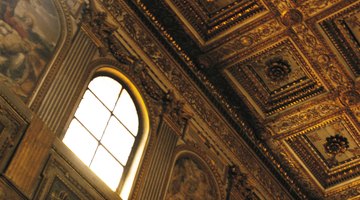What Is the Difference Between a Coffered & a Tray Ceiling?
Coffered and tray ceilings add architectural interest to a room by adding detail and depth the ceiling expanse. Both ceiling types feature recessed ceiling sections above geometric arrangements of box beams or deep molding.

Though coffered and tray ceilings share some characteristics and decorative options, they do have distinct differences.
Description
Coffered ceilings consist of beams or molding arranged in a grid. Because the grid hangs lower than the flat portion of the ceiling, it creates boxlike ceiling sections. The sections are typically square or rectangular. Though they're less common, you'll occasionally see coffered ceilings arranged to create intricate, octagon-shaped sections.
The beams or molding on tray ceiling borders the room's perimeter, which creates a single recessed ceiling section -- as if you topped the room with an inverted tray. The recessed ceiling areas typically have a rectangular or square shape, depending on the shape of the room. More elaborate versions may feature beams or molding arranged in a hexagonal or octagonal shape.
Design
Both coffered and tray ceilings suit a wide range of decorating styles, depending on how they're constructed. The clean-lined look of box beams covered in drywall suits contemporary and casual spaces. Adding decorative moldings to either ceiling type dresses up the look, making it appropriate for traditional or historical interiors ranging from casual to formal.
Though coffered ceilings traditionally have recessed sections deep enough to create the boxlike look, you can get a similar effect with a crisscrossed arrangement of boards or shallow trim. Those materials won't give you the look of a tray ceiling. Installing boards or trim looks decorative around the ceiling's perimeter, but tray ceilings require more depth.
Varying the beam width alters the look on both coffered and tray ceilings, but tray ceilings are better suited for widths greater than 10 inches in residential rooms. Tray ceilings sometimes have two more stair-stepped beams, which creates a grander, more dramatic look than a single layer.
Finishes
With both coffered and tray ceilings, painting the beams or molding to match the rest of your room's trim creates a cohesive look. Paint options for the recessed ceiling areas include painting them to match the room's trim, painting them to match the walls and painting them with a third color. Wallpapering the recessed sections is another option, as is covering them stamped metal tiles or their plastic lookalikes. Applying gold or silver leaf to the entire ceiling complements formal spaces.
Painting the recessed portion of the ceiling with a mural turns the ceiling into a focal point, but murals work best on tray ceilings. Because coffered ceilings have numerous recessed panels, painting a mural on each one usually looks too busy.
Distressed wood beams and molding create a rustic, weathered effect. Staining them results in a more traditional look. Though you can distress or stain the beams on either ceiling type, both looks suit coffered ceilings best. With coffered ceilings, stained beams are sometimes paired with stained-to-match wood panels, which are attached to the recessed ceiling sections.
Other Names
If you're considering a coffered or tray ceiling for your remodel or new construction, your builder may refer to both types by different names. Coffered ceilings are occasionally called beam and panel ceilings or box beam ceilings. Alternative names for tray -- sometimes spelled trey -- ceilings include pocket ceilings and recessed ceilings.
The Drip Cap
- Coffered and tray ceilings add architectural interest to a room by adding detail and depth the ceiling expanse.
- Both ceiling types feature recessed ceiling sections above geometric arrangements of box beams or deep molding.
- Though coffered and tray ceilings share some characteristics and decorative options, they do have distinct differences.
- The clean-lined look of box beams covered in drywall suits contemporary and casual spaces.
- Adding decorative moldings to either ceiling type dresses up the look, making it appropriate for traditional or historical interiors ranging from casual to formal.
- With coffered ceilings, stained beams are sometimes paired with stained-to-match wood panels, which are attached to the recessed ceiling sections.
References
- Fine Homebuilding; A Coffered Ceiling Begins with Box Beams; Joseph B. Lanza
Resources
Writer Bio
Leah James has been a full-time freelance writer and editor since 2008. With more than a decade of experience in interior decorating, she frequently writes about home design. She studied English literature at Lyon College.
Photo Credits
- John Foxx/Stockbyte/Getty Images
- John Foxx/Stockbyte/Getty Images
More Articles



